Program Planning and Evaluation for Non-Communicable Diseases Report
VerifiedAdded on 2020/04/15
|15
|4070
|34
Report
AI Summary
This report presents a comprehensive program plan for addressing non-communicable diseases (NCDs) within a specific school and surrounding community. It begins with an introduction to NCDs, emphasizing their impact and contributing factors like lifestyle and environmental influences. The report then delves into the demographic characteristics of Ardross Primary School, highlighting the importance of understanding the community for effective intervention. It explores the etiologic and epidemiological aspects of overweight and obesity within the target group, which includes teachers, and justifies the selection of this stakeholder group. The core of the report outlines intervention and planning strategies, including programs like "Great Fun2Run" and the development of interactive resources. A communication strategy is proposed, and an evaluation framework is established to measure the program's effectiveness. The report concludes with a discussion of the resources required, potential barriers, and the overall aim of promoting a healthy lifestyle to reduce NCD risks. The report is a valuable resource for students, offering insights into public health program development and evaluation.

Progra
m
Planni
ng
and
evalua
tion in
Public
Health
m
Planni
ng
and
evalua
tion in
Public
Health
Secure Best Marks with AI Grader
Need help grading? Try our AI Grader for instant feedback on your assignments.
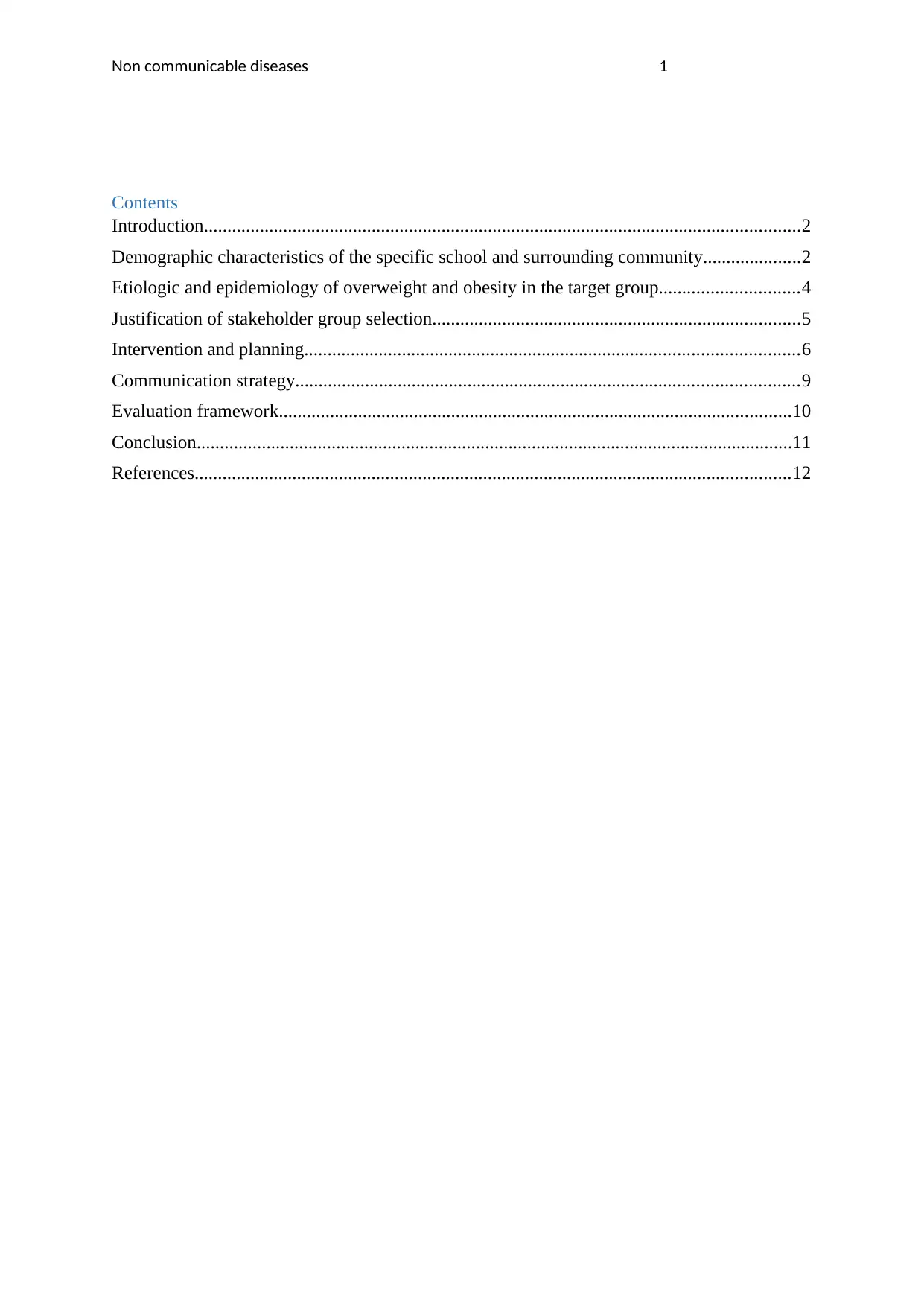
Non communicable diseases 1
Contents
Introduction................................................................................................................................2
Demographic characteristics of the specific school and surrounding community.....................2
Etiologic and epidemiology of overweight and obesity in the target group..............................4
Justification of stakeholder group selection...............................................................................5
Intervention and planning..........................................................................................................6
Communication strategy............................................................................................................9
Evaluation framework..............................................................................................................10
Conclusion................................................................................................................................11
References................................................................................................................................12
Contents
Introduction................................................................................................................................2
Demographic characteristics of the specific school and surrounding community.....................2
Etiologic and epidemiology of overweight and obesity in the target group..............................4
Justification of stakeholder group selection...............................................................................5
Intervention and planning..........................................................................................................6
Communication strategy............................................................................................................9
Evaluation framework..............................................................................................................10
Conclusion................................................................................................................................11
References................................................................................................................................12
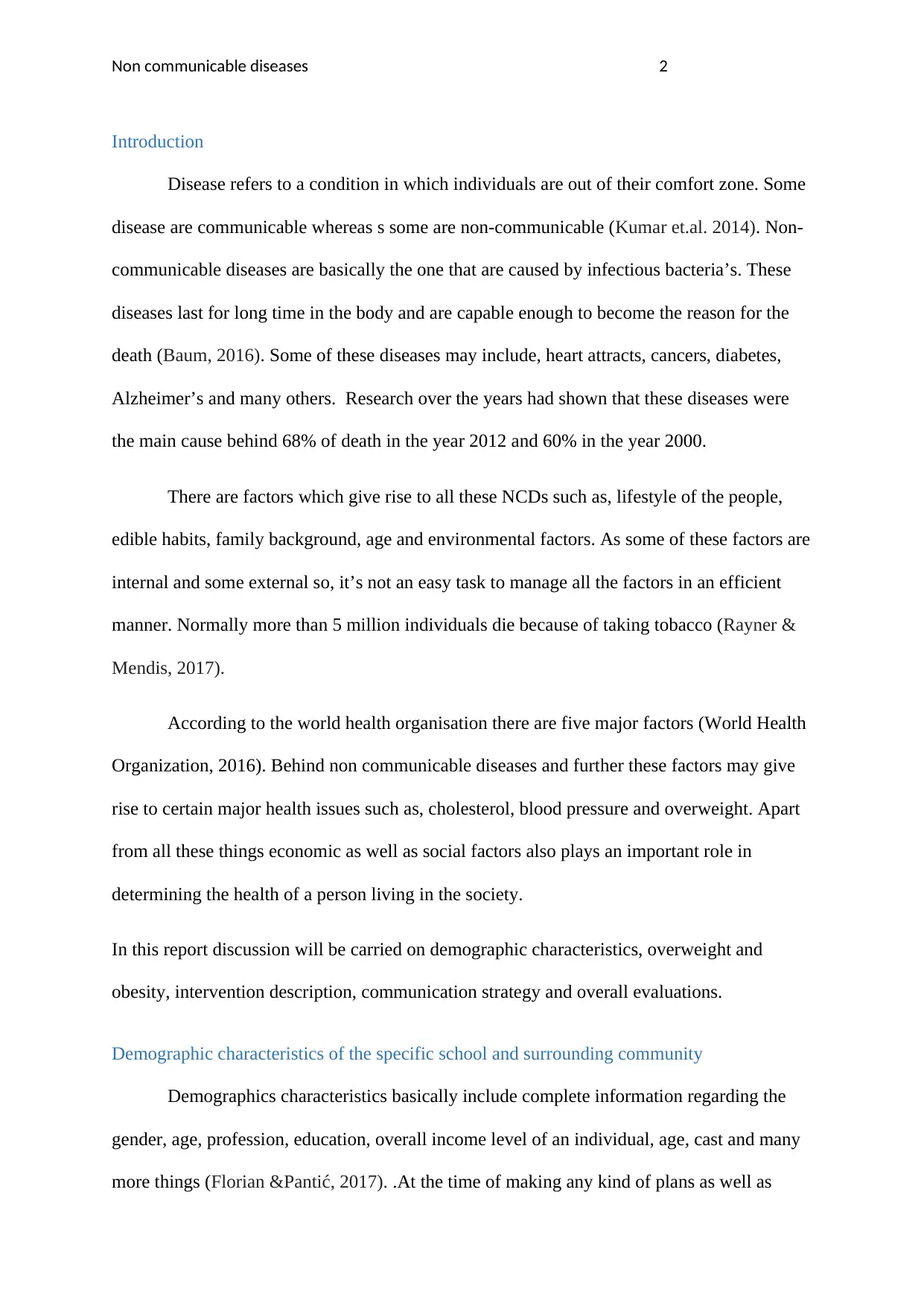
Non communicable diseases 2
Introduction
Disease refers to a condition in which individuals are out of their comfort zone. Some
disease are communicable whereas s some are non-communicable (Kumar et.al. 2014). Non-
communicable diseases are basically the one that are caused by infectious bacteria’s. These
diseases last for long time in the body and are capable enough to become the reason for the
death (Baum, 2016). Some of these diseases may include, heart attracts, cancers, diabetes,
Alzheimer’s and many others. Research over the years had shown that these diseases were
the main cause behind 68% of death in the year 2012 and 60% in the year 2000.
There are factors which give rise to all these NCDs such as, lifestyle of the people,
edible habits, family background, age and environmental factors. As some of these factors are
internal and some external so, it’s not an easy task to manage all the factors in an efficient
manner. Normally more than 5 million individuals die because of taking tobacco (Rayner &
Mendis, 2017).
According to the world health organisation there are five major factors (World Health
Organization, 2016). Behind non communicable diseases and further these factors may give
rise to certain major health issues such as, cholesterol, blood pressure and overweight. Apart
from all these things economic as well as social factors also plays an important role in
determining the health of a person living in the society.
In this report discussion will be carried on demographic characteristics, overweight and
obesity, intervention description, communication strategy and overall evaluations.
Demographic characteristics of the specific school and surrounding community
Demographics characteristics basically include complete information regarding the
gender, age, profession, education, overall income level of an individual, age, cast and many
more things (Florian &Pantić, 2017). .At the time of making any kind of plans as well as
Introduction
Disease refers to a condition in which individuals are out of their comfort zone. Some
disease are communicable whereas s some are non-communicable (Kumar et.al. 2014). Non-
communicable diseases are basically the one that are caused by infectious bacteria’s. These
diseases last for long time in the body and are capable enough to become the reason for the
death (Baum, 2016). Some of these diseases may include, heart attracts, cancers, diabetes,
Alzheimer’s and many others. Research over the years had shown that these diseases were
the main cause behind 68% of death in the year 2012 and 60% in the year 2000.
There are factors which give rise to all these NCDs such as, lifestyle of the people,
edible habits, family background, age and environmental factors. As some of these factors are
internal and some external so, it’s not an easy task to manage all the factors in an efficient
manner. Normally more than 5 million individuals die because of taking tobacco (Rayner &
Mendis, 2017).
According to the world health organisation there are five major factors (World Health
Organization, 2016). Behind non communicable diseases and further these factors may give
rise to certain major health issues such as, cholesterol, blood pressure and overweight. Apart
from all these things economic as well as social factors also plays an important role in
determining the health of a person living in the society.
In this report discussion will be carried on demographic characteristics, overweight and
obesity, intervention description, communication strategy and overall evaluations.
Demographic characteristics of the specific school and surrounding community
Demographics characteristics basically include complete information regarding the
gender, age, profession, education, overall income level of an individual, age, cast and many
more things (Florian &Pantić, 2017). .At the time of making any kind of plans as well as
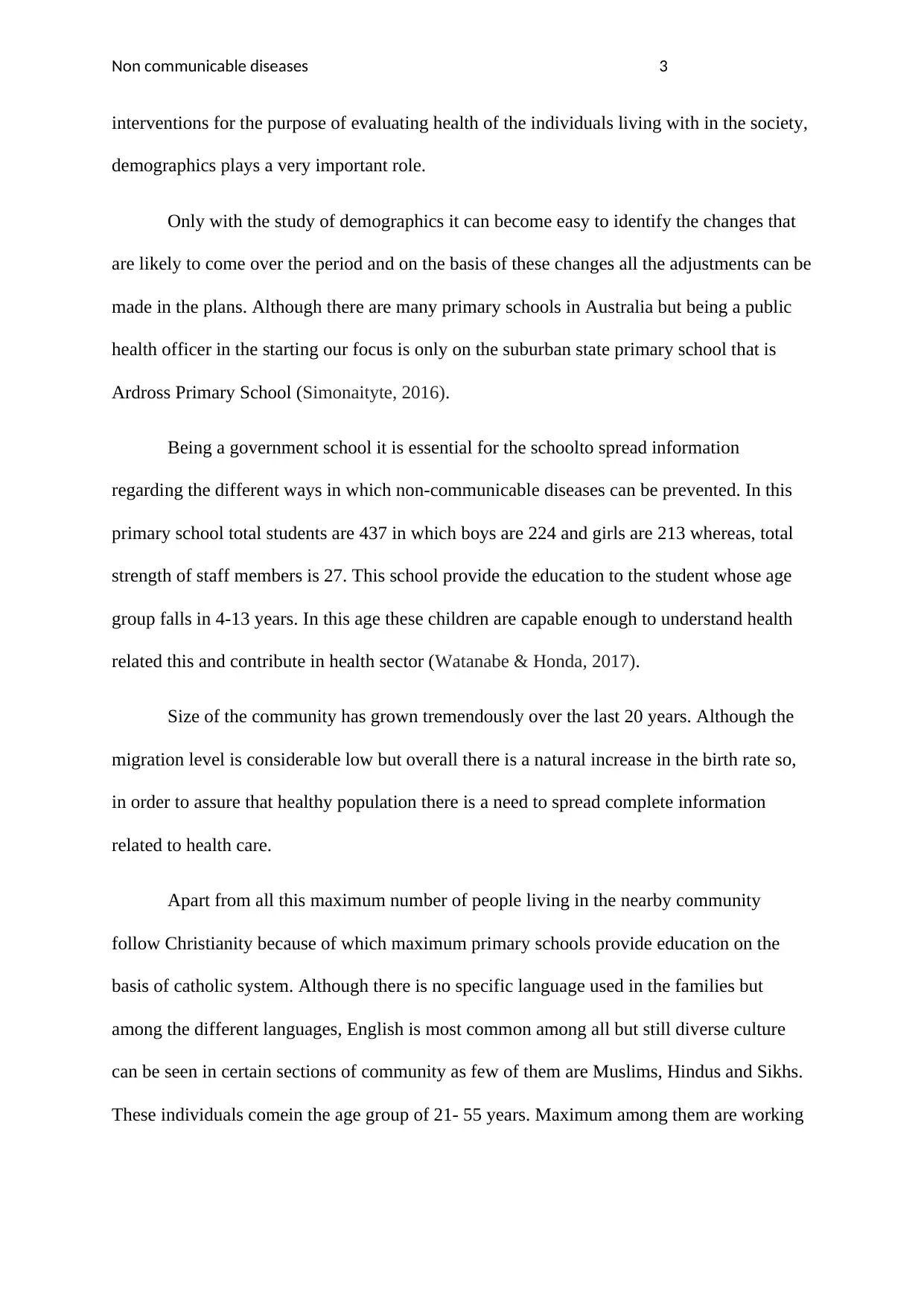
Non communicable diseases 3
interventions for the purpose of evaluating health of the individuals living with in the society,
demographics plays a very important role.
Only with the study of demographics it can become easy to identify the changes that
are likely to come over the period and on the basis of these changes all the adjustments can be
made in the plans. Although there are many primary schools in Australia but being a public
health officer in the starting our focus is only on the suburban state primary school that is
Ardross Primary School (Simonaityte, 2016).
Being a government school it is essential for the schoolto spread information
regarding the different ways in which non-communicable diseases can be prevented. In this
primary school total students are 437 in which boys are 224 and girls are 213 whereas, total
strength of staff members is 27. This school provide the education to the student whose age
group falls in 4-13 years. In this age these children are capable enough to understand health
related this and contribute in health sector (Watanabe & Honda, 2017).
Size of the community has grown tremendously over the last 20 years. Although the
migration level is considerable low but overall there is a natural increase in the birth rate so,
in order to assure that healthy population there is a need to spread complete information
related to health care.
Apart from all this maximum number of people living in the nearby community
follow Christianity because of which maximum primary schools provide education on the
basis of catholic system. Although there is no specific language used in the families but
among the different languages, English is most common among all but still diverse culture
can be seen in certain sections of community as few of them are Muslims, Hindus and Sikhs.
These individuals comein the age group of 21- 55 years. Maximum among them are working
interventions for the purpose of evaluating health of the individuals living with in the society,
demographics plays a very important role.
Only with the study of demographics it can become easy to identify the changes that
are likely to come over the period and on the basis of these changes all the adjustments can be
made in the plans. Although there are many primary schools in Australia but being a public
health officer in the starting our focus is only on the suburban state primary school that is
Ardross Primary School (Simonaityte, 2016).
Being a government school it is essential for the schoolto spread information
regarding the different ways in which non-communicable diseases can be prevented. In this
primary school total students are 437 in which boys are 224 and girls are 213 whereas, total
strength of staff members is 27. This school provide the education to the student whose age
group falls in 4-13 years. In this age these children are capable enough to understand health
related this and contribute in health sector (Watanabe & Honda, 2017).
Size of the community has grown tremendously over the last 20 years. Although the
migration level is considerable low but overall there is a natural increase in the birth rate so,
in order to assure that healthy population there is a need to spread complete information
related to health care.
Apart from all this maximum number of people living in the nearby community
follow Christianity because of which maximum primary schools provide education on the
basis of catholic system. Although there is no specific language used in the families but
among the different languages, English is most common among all but still diverse culture
can be seen in certain sections of community as few of them are Muslims, Hindus and Sikhs.
These individuals comein the age group of 21- 55 years. Maximum among them are working
Secure Best Marks with AI Grader
Need help grading? Try our AI Grader for instant feedback on your assignments.
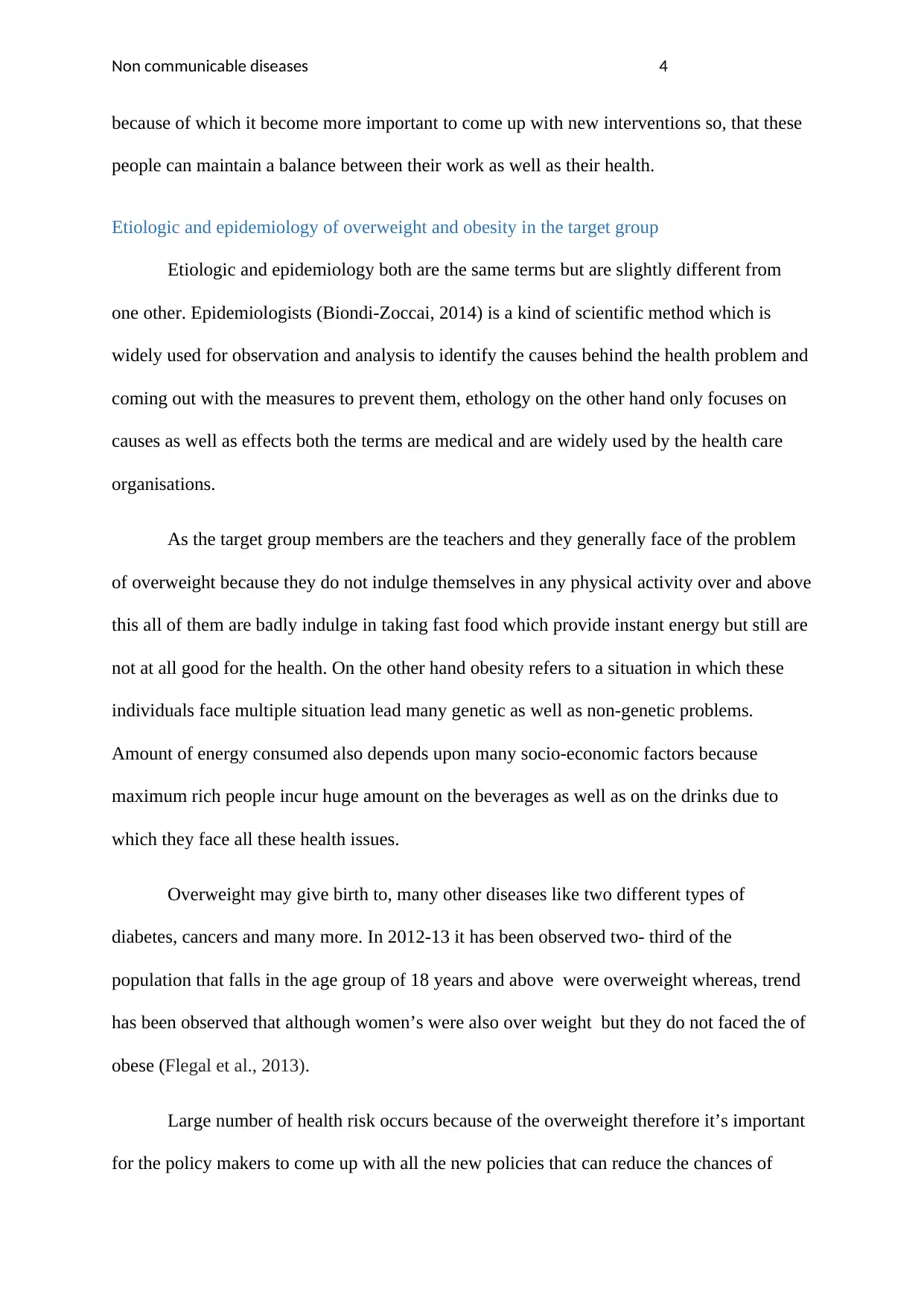
Non communicable diseases 4
because of which it become more important to come up with new interventions so, that these
people can maintain a balance between their work as well as their health.
Etiologic and epidemiology of overweight and obesity in the target group
Etiologic and epidemiology both are the same terms but are slightly different from
one other. Epidemiologists (Biondi-Zoccai, 2014) is a kind of scientific method which is
widely used for observation and analysis to identify the causes behind the health problem and
coming out with the measures to prevent them, ethology on the other hand only focuses on
causes as well as effects both the terms are medical and are widely used by the health care
organisations.
As the target group members are the teachers and they generally face of the problem
of overweight because they do not indulge themselves in any physical activity over and above
this all of them are badly indulge in taking fast food which provide instant energy but still are
not at all good for the health. On the other hand obesity refers to a situation in which these
individuals face multiple situation lead many genetic as well as non-genetic problems.
Amount of energy consumed also depends upon many socio-economic factors because
maximum rich people incur huge amount on the beverages as well as on the drinks due to
which they face all these health issues.
Overweight may give birth to, many other diseases like two different types of
diabetes, cancers and many more. In 2012-13 it has been observed two- third of the
population that falls in the age group of 18 years and above were overweight whereas, trend
has been observed that although women’s were also over weight but they do not faced the of
obese (Flegal et al., 2013).
Large number of health risk occurs because of the overweight therefore it’s important
for the policy makers to come up with all the new policies that can reduce the chances of
because of which it become more important to come up with new interventions so, that these
people can maintain a balance between their work as well as their health.
Etiologic and epidemiology of overweight and obesity in the target group
Etiologic and epidemiology both are the same terms but are slightly different from
one other. Epidemiologists (Biondi-Zoccai, 2014) is a kind of scientific method which is
widely used for observation and analysis to identify the causes behind the health problem and
coming out with the measures to prevent them, ethology on the other hand only focuses on
causes as well as effects both the terms are medical and are widely used by the health care
organisations.
As the target group members are the teachers and they generally face of the problem
of overweight because they do not indulge themselves in any physical activity over and above
this all of them are badly indulge in taking fast food which provide instant energy but still are
not at all good for the health. On the other hand obesity refers to a situation in which these
individuals face multiple situation lead many genetic as well as non-genetic problems.
Amount of energy consumed also depends upon many socio-economic factors because
maximum rich people incur huge amount on the beverages as well as on the drinks due to
which they face all these health issues.
Overweight may give birth to, many other diseases like two different types of
diabetes, cancers and many more. In 2012-13 it has been observed two- third of the
population that falls in the age group of 18 years and above were overweight whereas, trend
has been observed that although women’s were also over weight but they do not faced the of
obese (Flegal et al., 2013).
Large number of health risk occurs because of the overweight therefore it’s important
for the policy makers to come up with all the new policies that can reduce the chances of
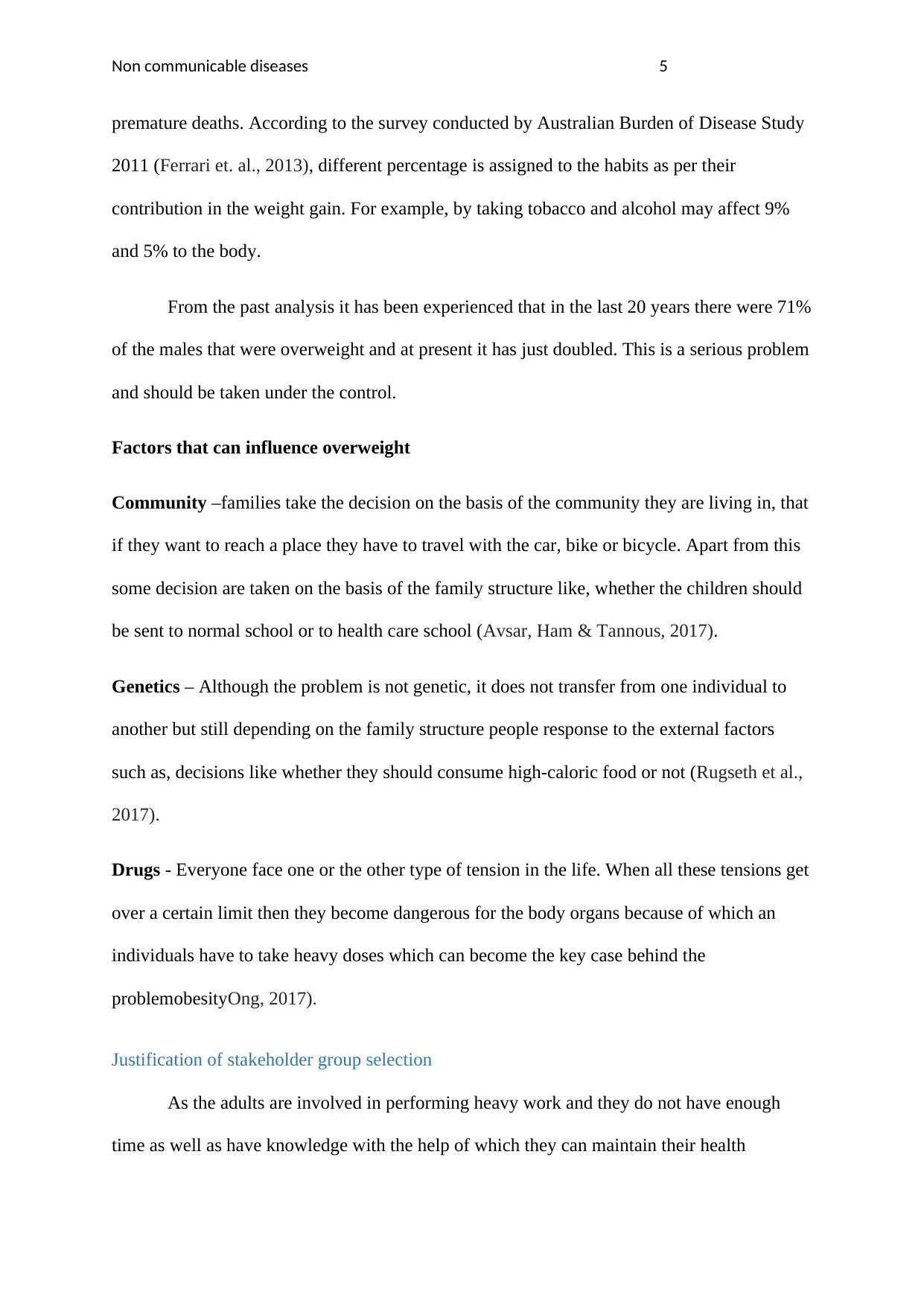
Non communicable diseases 5
premature deaths. According to the survey conducted by Australian Burden of Disease Study
2011 (Ferrari et. al., 2013), different percentage is assigned to the habits as per their
contribution in the weight gain. For example, by taking tobacco and alcohol may affect 9%
and 5% to the body.
From the past analysis it has been experienced that in the last 20 years there were 71%
of the males that were overweight and at present it has just doubled. This is a serious problem
and should be taken under the control.
Factors that can influence overweight
Community –families take the decision on the basis of the community they are living in, that
if they want to reach a place they have to travel with the car, bike or bicycle. Apart from this
some decision are taken on the basis of the family structure like, whether the children should
be sent to normal school or to health care school (Avsar, Ham & Tannous, 2017).
Genetics – Although the problem is not genetic, it does not transfer from one individual to
another but still depending on the family structure people response to the external factors
such as, decisions like whether they should consume high-caloric food or not (Rugseth et al.,
2017).
Drugs - Everyone face one or the other type of tension in the life. When all these tensions get
over a certain limit then they become dangerous for the body organs because of which an
individuals have to take heavy doses which can become the key case behind the
problemobesityOng, 2017).
Justification of stakeholder group selection
As the adults are involved in performing heavy work and they do not have enough
time as well as have knowledge with the help of which they can maintain their health
premature deaths. According to the survey conducted by Australian Burden of Disease Study
2011 (Ferrari et. al., 2013), different percentage is assigned to the habits as per their
contribution in the weight gain. For example, by taking tobacco and alcohol may affect 9%
and 5% to the body.
From the past analysis it has been experienced that in the last 20 years there were 71%
of the males that were overweight and at present it has just doubled. This is a serious problem
and should be taken under the control.
Factors that can influence overweight
Community –families take the decision on the basis of the community they are living in, that
if they want to reach a place they have to travel with the car, bike or bicycle. Apart from this
some decision are taken on the basis of the family structure like, whether the children should
be sent to normal school or to health care school (Avsar, Ham & Tannous, 2017).
Genetics – Although the problem is not genetic, it does not transfer from one individual to
another but still depending on the family structure people response to the external factors
such as, decisions like whether they should consume high-caloric food or not (Rugseth et al.,
2017).
Drugs - Everyone face one or the other type of tension in the life. When all these tensions get
over a certain limit then they become dangerous for the body organs because of which an
individuals have to take heavy doses which can become the key case behind the
problemobesityOng, 2017).
Justification of stakeholder group selection
As the adults are involved in performing heavy work and they do not have enough
time as well as have knowledge with the help of which they can maintain their health
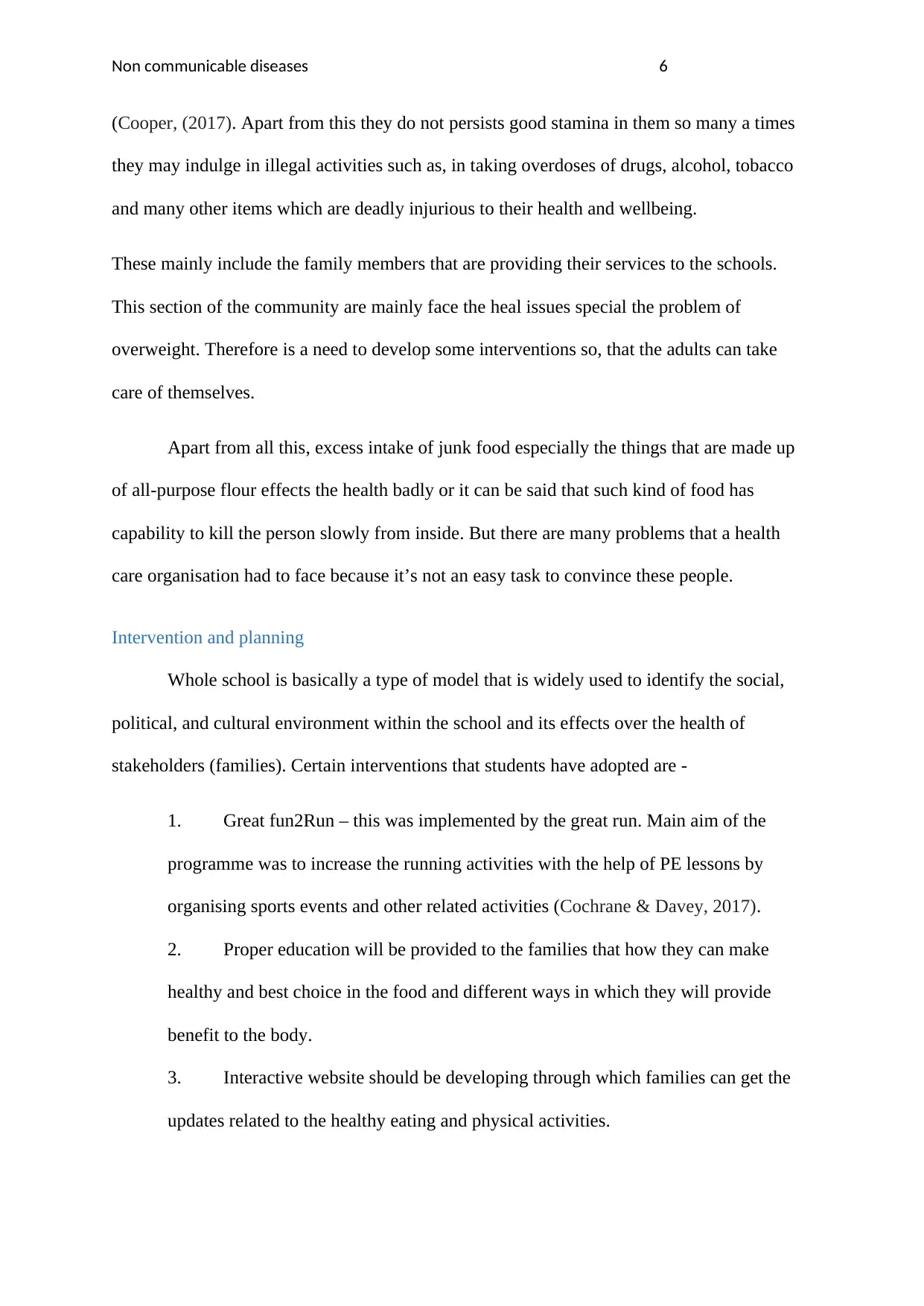
Non communicable diseases 6
(Cooper, (2017). Apart from this they do not persists good stamina in them so many a times
they may indulge in illegal activities such as, in taking overdoses of drugs, alcohol, tobacco
and many other items which are deadly injurious to their health and wellbeing.
These mainly include the family members that are providing their services to the schools.
This section of the community are mainly face the heal issues special the problem of
overweight. Therefore is a need to develop some interventions so, that the adults can take
care of themselves.
Apart from all this, excess intake of junk food especially the things that are made up
of all-purpose flour effects the health badly or it can be said that such kind of food has
capability to kill the person slowly from inside. But there are many problems that a health
care organisation had to face because it’s not an easy task to convince these people.
Intervention and planning
Whole school is basically a type of model that is widely used to identify the social,
political, and cultural environment within the school and its effects over the health of
stakeholders (families). Certain interventions that students have adopted are -
1. Great fun2Run – this was implemented by the great run. Main aim of the
programme was to increase the running activities with the help of PE lessons by
organising sports events and other related activities (Cochrane & Davey, 2017).
2. Proper education will be provided to the families that how they can make
healthy and best choice in the food and different ways in which they will provide
benefit to the body.
3. Interactive website should be developing through which families can get the
updates related to the healthy eating and physical activities.
(Cooper, (2017). Apart from this they do not persists good stamina in them so many a times
they may indulge in illegal activities such as, in taking overdoses of drugs, alcohol, tobacco
and many other items which are deadly injurious to their health and wellbeing.
These mainly include the family members that are providing their services to the schools.
This section of the community are mainly face the heal issues special the problem of
overweight. Therefore is a need to develop some interventions so, that the adults can take
care of themselves.
Apart from all this, excess intake of junk food especially the things that are made up
of all-purpose flour effects the health badly or it can be said that such kind of food has
capability to kill the person slowly from inside. But there are many problems that a health
care organisation had to face because it’s not an easy task to convince these people.
Intervention and planning
Whole school is basically a type of model that is widely used to identify the social,
political, and cultural environment within the school and its effects over the health of
stakeholders (families). Certain interventions that students have adopted are -
1. Great fun2Run – this was implemented by the great run. Main aim of the
programme was to increase the running activities with the help of PE lessons by
organising sports events and other related activities (Cochrane & Davey, 2017).
2. Proper education will be provided to the families that how they can make
healthy and best choice in the food and different ways in which they will provide
benefit to the body.
3. Interactive website should be developing through which families can get the
updates related to the healthy eating and physical activities.
Paraphrase This Document
Need a fresh take? Get an instant paraphrase of this document with our AI Paraphraser
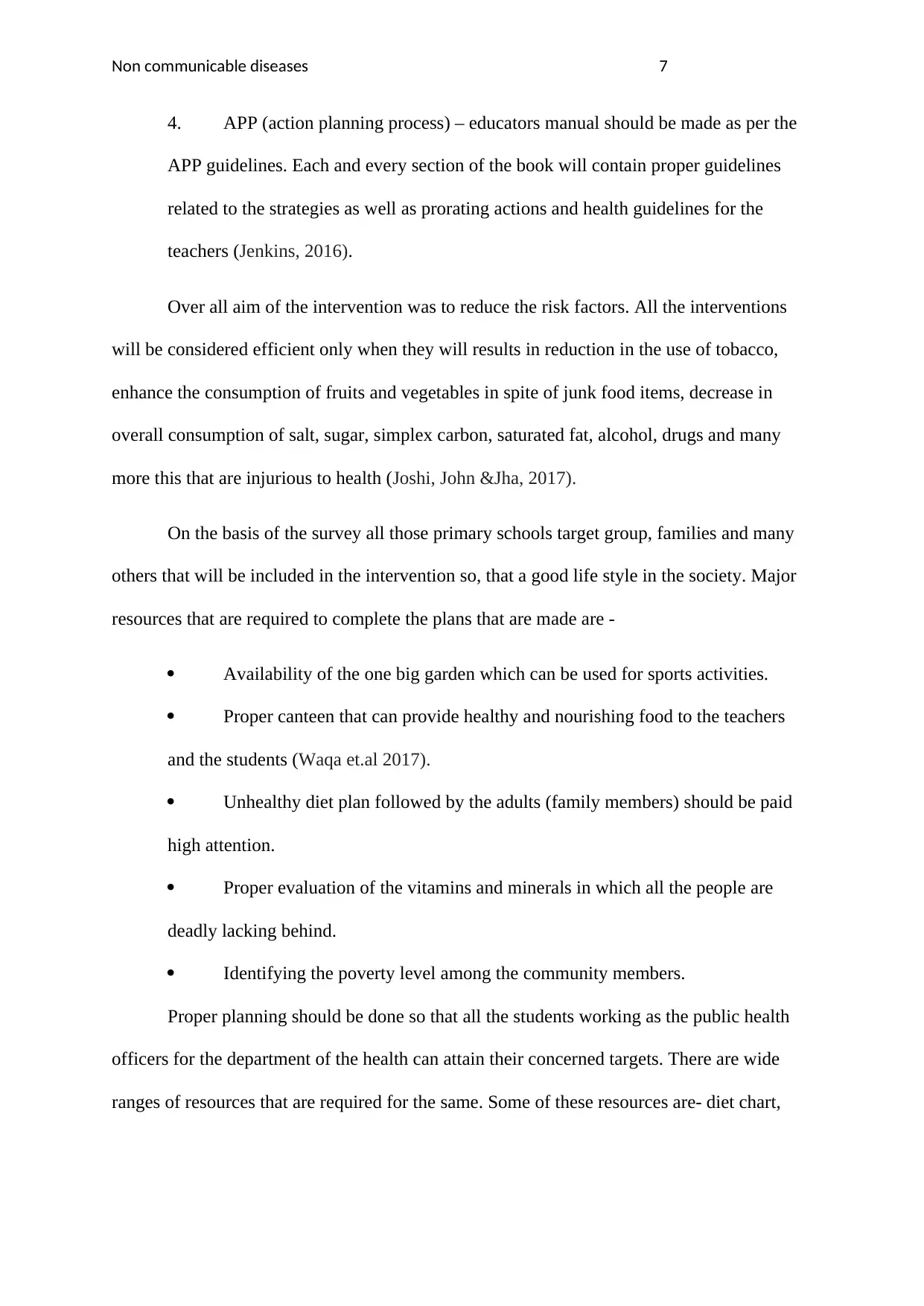
Non communicable diseases 7
4. APP (action planning process) – educators manual should be made as per the
APP guidelines. Each and every section of the book will contain proper guidelines
related to the strategies as well as prorating actions and health guidelines for the
teachers (Jenkins, 2016).
Over all aim of the intervention was to reduce the risk factors. All the interventions
will be considered efficient only when they will results in reduction in the use of tobacco,
enhance the consumption of fruits and vegetables in spite of junk food items, decrease in
overall consumption of salt, sugar, simplex carbon, saturated fat, alcohol, drugs and many
more this that are injurious to health (Joshi, John &Jha, 2017).
On the basis of the survey all those primary schools target group, families and many
others that will be included in the intervention so, that a good life style in the society. Major
resources that are required to complete the plans that are made are -
Availability of the one big garden which can be used for sports activities.
Proper canteen that can provide healthy and nourishing food to the teachers
and the students (Waqa et.al 2017).
Unhealthy diet plan followed by the adults (family members) should be paid
high attention.
Proper evaluation of the vitamins and minerals in which all the people are
deadly lacking behind.
Identifying the poverty level among the community members.
Proper planning should be done so that all the students working as the public health
officers for the department of the health can attain their concerned targets. There are wide
ranges of resources that are required for the same. Some of these resources are- diet chart,
4. APP (action planning process) – educators manual should be made as per the
APP guidelines. Each and every section of the book will contain proper guidelines
related to the strategies as well as prorating actions and health guidelines for the
teachers (Jenkins, 2016).
Over all aim of the intervention was to reduce the risk factors. All the interventions
will be considered efficient only when they will results in reduction in the use of tobacco,
enhance the consumption of fruits and vegetables in spite of junk food items, decrease in
overall consumption of salt, sugar, simplex carbon, saturated fat, alcohol, drugs and many
more this that are injurious to health (Joshi, John &Jha, 2017).
On the basis of the survey all those primary schools target group, families and many
others that will be included in the intervention so, that a good life style in the society. Major
resources that are required to complete the plans that are made are -
Availability of the one big garden which can be used for sports activities.
Proper canteen that can provide healthy and nourishing food to the teachers
and the students (Waqa et.al 2017).
Unhealthy diet plan followed by the adults (family members) should be paid
high attention.
Proper evaluation of the vitamins and minerals in which all the people are
deadly lacking behind.
Identifying the poverty level among the community members.
Proper planning should be done so that all the students working as the public health
officers for the department of the health can attain their concerned targets. There are wide
ranges of resources that are required for the same. Some of these resources are- diet chart,
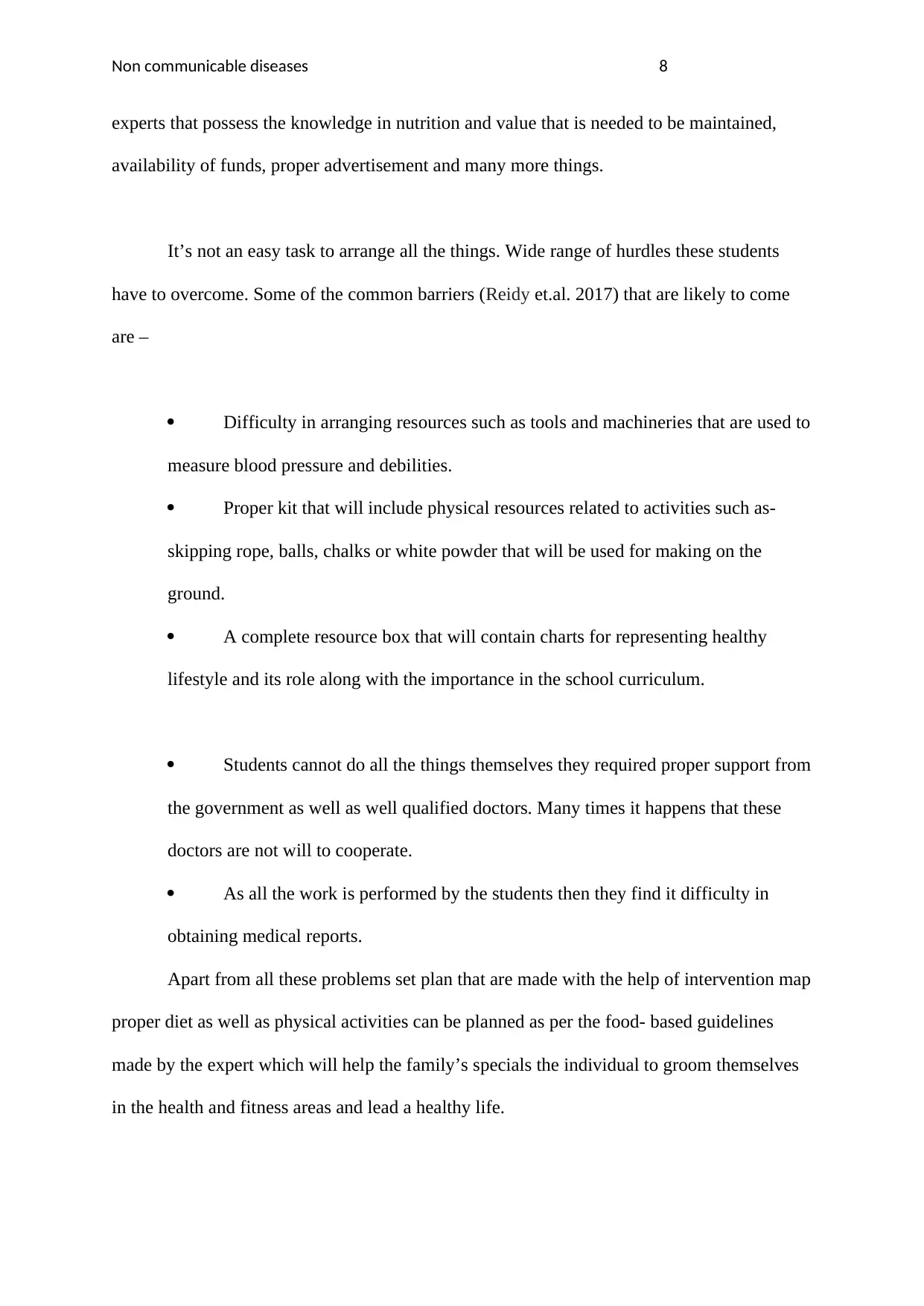
Non communicable diseases 8
experts that possess the knowledge in nutrition and value that is needed to be maintained,
availability of funds, proper advertisement and many more things.
It’s not an easy task to arrange all the things. Wide range of hurdles these students
have to overcome. Some of the common barriers (Reidy et.al. 2017) that are likely to come
are –
Difficulty in arranging resources such as tools and machineries that are used to
measure blood pressure and debilities.
Proper kit that will include physical resources related to activities such as-
skipping rope, balls, chalks or white powder that will be used for making on the
ground.
A complete resource box that will contain charts for representing healthy
lifestyle and its role along with the importance in the school curriculum.
Students cannot do all the things themselves they required proper support from
the government as well as well qualified doctors. Many times it happens that these
doctors are not will to cooperate.
As all the work is performed by the students then they find it difficulty in
obtaining medical reports.
Apart from all these problems set plan that are made with the help of intervention map
proper diet as well as physical activities can be planned as per the food- based guidelines
made by the expert which will help the family’s specials the individual to groom themselves
in the health and fitness areas and lead a healthy life.
experts that possess the knowledge in nutrition and value that is needed to be maintained,
availability of funds, proper advertisement and many more things.
It’s not an easy task to arrange all the things. Wide range of hurdles these students
have to overcome. Some of the common barriers (Reidy et.al. 2017) that are likely to come
are –
Difficulty in arranging resources such as tools and machineries that are used to
measure blood pressure and debilities.
Proper kit that will include physical resources related to activities such as-
skipping rope, balls, chalks or white powder that will be used for making on the
ground.
A complete resource box that will contain charts for representing healthy
lifestyle and its role along with the importance in the school curriculum.
Students cannot do all the things themselves they required proper support from
the government as well as well qualified doctors. Many times it happens that these
doctors are not will to cooperate.
As all the work is performed by the students then they find it difficulty in
obtaining medical reports.
Apart from all these problems set plan that are made with the help of intervention map
proper diet as well as physical activities can be planned as per the food- based guidelines
made by the expert which will help the family’s specials the individual to groom themselves
in the health and fitness areas and lead a healthy life.
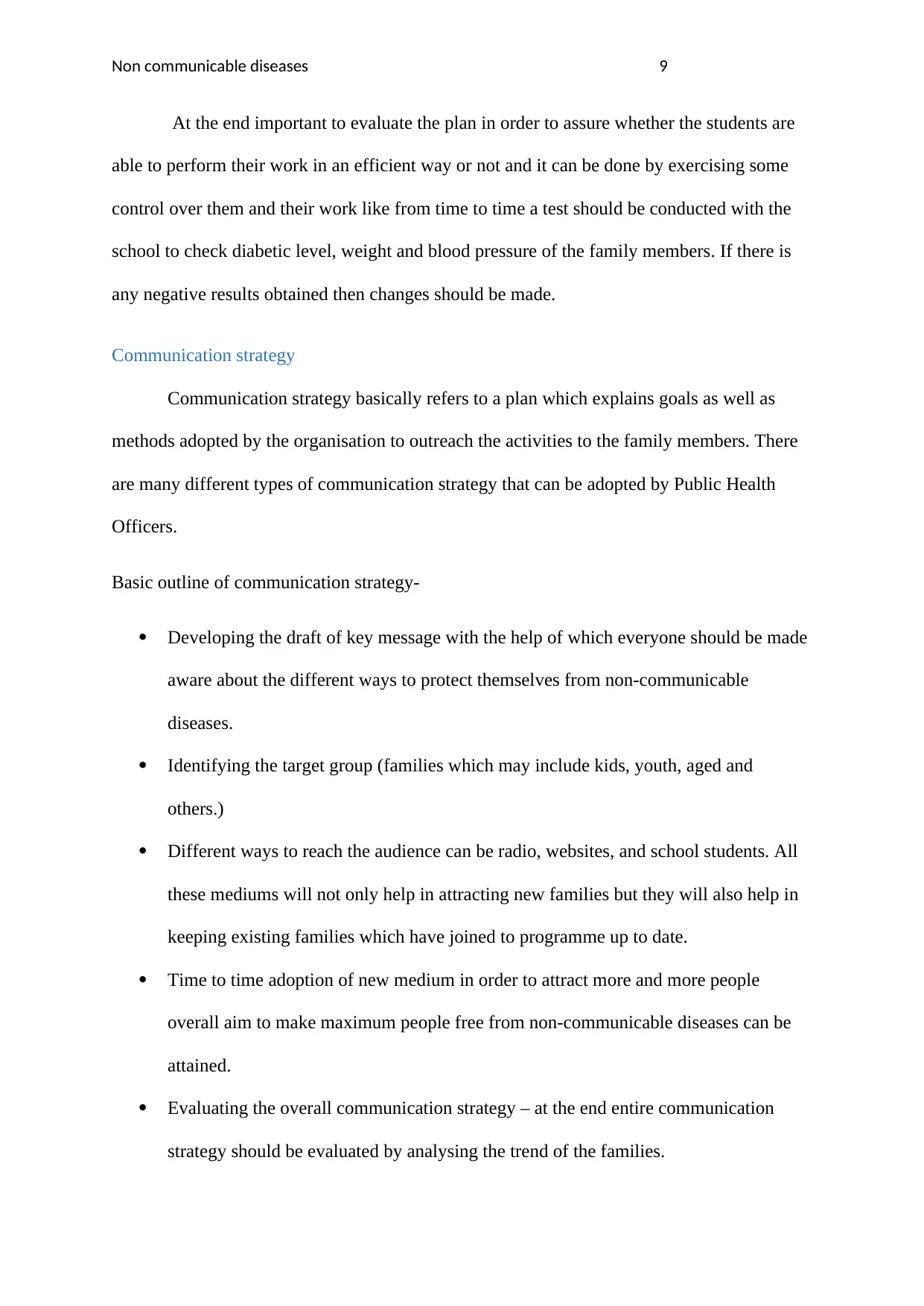
Non communicable diseases 9
At the end important to evaluate the plan in order to assure whether the students are
able to perform their work in an efficient way or not and it can be done by exercising some
control over them and their work like from time to time a test should be conducted with the
school to check diabetic level, weight and blood pressure of the family members. If there is
any negative results obtained then changes should be made.
Communication strategy
Communication strategy basically refers to a plan which explains goals as well as
methods adopted by the organisation to outreach the activities to the family members. There
are many different types of communication strategy that can be adopted by Public Health
Officers.
Basic outline of communication strategy-
Developing the draft of key message with the help of which everyone should be made
aware about the different ways to protect themselves from non-communicable
diseases.
Identifying the target group (families which may include kids, youth, aged and
others.)
Different ways to reach the audience can be radio, websites, and school students. All
these mediums will not only help in attracting new families but they will also help in
keeping existing families which have joined to programme up to date.
Time to time adoption of new medium in order to attract more and more people
overall aim to make maximum people free from non-communicable diseases can be
attained.
Evaluating the overall communication strategy – at the end entire communication
strategy should be evaluated by analysing the trend of the families.
At the end important to evaluate the plan in order to assure whether the students are
able to perform their work in an efficient way or not and it can be done by exercising some
control over them and their work like from time to time a test should be conducted with the
school to check diabetic level, weight and blood pressure of the family members. If there is
any negative results obtained then changes should be made.
Communication strategy
Communication strategy basically refers to a plan which explains goals as well as
methods adopted by the organisation to outreach the activities to the family members. There
are many different types of communication strategy that can be adopted by Public Health
Officers.
Basic outline of communication strategy-
Developing the draft of key message with the help of which everyone should be made
aware about the different ways to protect themselves from non-communicable
diseases.
Identifying the target group (families which may include kids, youth, aged and
others.)
Different ways to reach the audience can be radio, websites, and school students. All
these mediums will not only help in attracting new families but they will also help in
keeping existing families which have joined to programme up to date.
Time to time adoption of new medium in order to attract more and more people
overall aim to make maximum people free from non-communicable diseases can be
attained.
Evaluating the overall communication strategy – at the end entire communication
strategy should be evaluated by analysing the trend of the families.
Secure Best Marks with AI Grader
Need help grading? Try our AI Grader for instant feedback on your assignments.
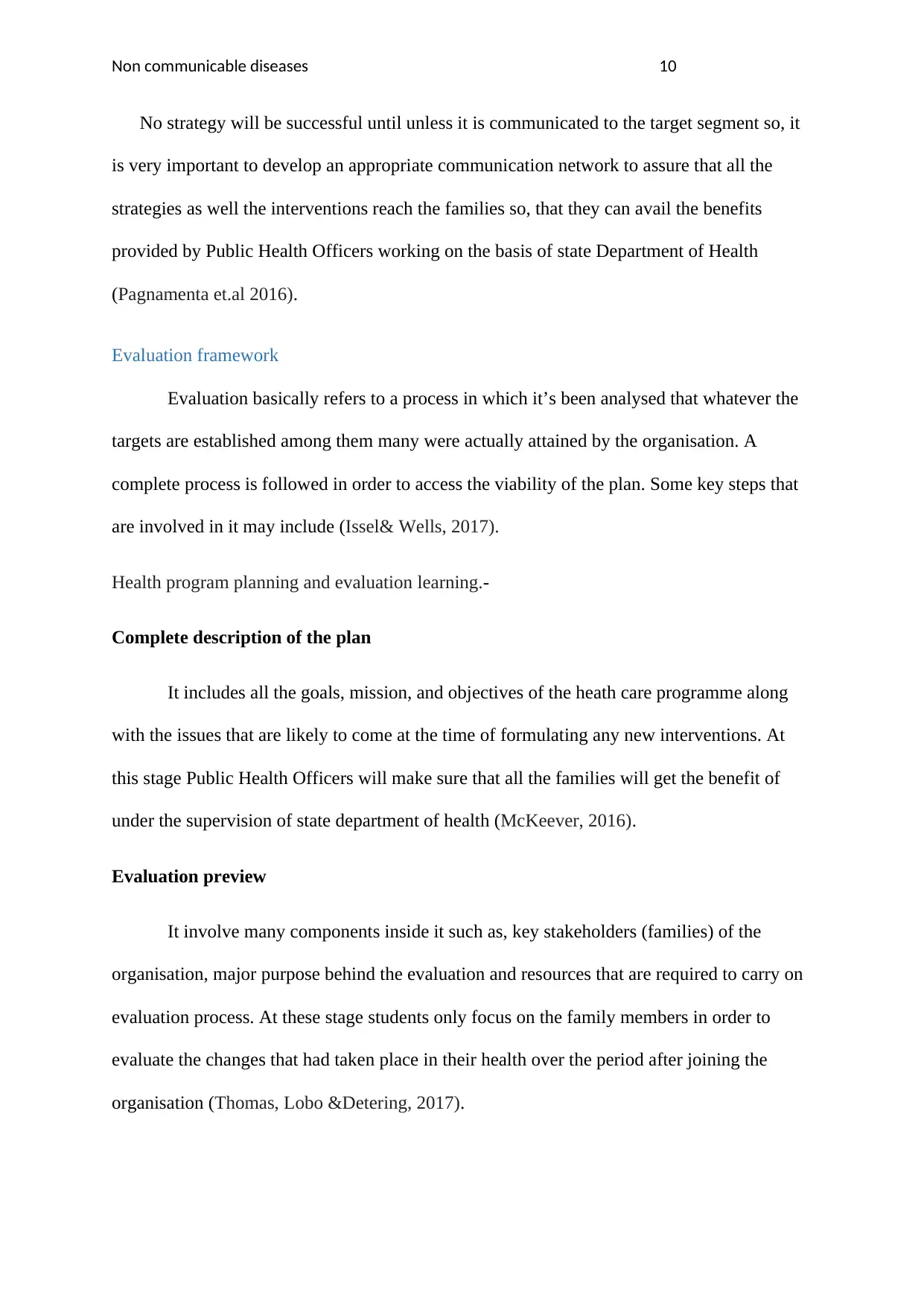
Non communicable diseases 10
No strategy will be successful until unless it is communicated to the target segment so, it
is very important to develop an appropriate communication network to assure that all the
strategies as well the interventions reach the families so, that they can avail the benefits
provided by Public Health Officers working on the basis of state Department of Health
(Pagnamenta et.al 2016).
Evaluation framework
Evaluation basically refers to a process in which it’s been analysed that whatever the
targets are established among them many were actually attained by the organisation. A
complete process is followed in order to access the viability of the plan. Some key steps that
are involved in it may include (Issel& Wells, 2017).
Health program planning and evaluation learning.-
Complete description of the plan
It includes all the goals, mission, and objectives of the heath care programme along
with the issues that are likely to come at the time of formulating any new interventions. At
this stage Public Health Officers will make sure that all the families will get the benefit of
under the supervision of state department of health (McKeever, 2016).
Evaluation preview
It involve many components inside it such as, key stakeholders (families) of the
organisation, major purpose behind the evaluation and resources that are required to carry on
evaluation process. At these stage students only focus on the family members in order to
evaluate the changes that had taken place in their health over the period after joining the
organisation (Thomas, Lobo &Detering, 2017).
No strategy will be successful until unless it is communicated to the target segment so, it
is very important to develop an appropriate communication network to assure that all the
strategies as well the interventions reach the families so, that they can avail the benefits
provided by Public Health Officers working on the basis of state Department of Health
(Pagnamenta et.al 2016).
Evaluation framework
Evaluation basically refers to a process in which it’s been analysed that whatever the
targets are established among them many were actually attained by the organisation. A
complete process is followed in order to access the viability of the plan. Some key steps that
are involved in it may include (Issel& Wells, 2017).
Health program planning and evaluation learning.-
Complete description of the plan
It includes all the goals, mission, and objectives of the heath care programme along
with the issues that are likely to come at the time of formulating any new interventions. At
this stage Public Health Officers will make sure that all the families will get the benefit of
under the supervision of state department of health (McKeever, 2016).
Evaluation preview
It involve many components inside it such as, key stakeholders (families) of the
organisation, major purpose behind the evaluation and resources that are required to carry on
evaluation process. At these stage students only focus on the family members in order to
evaluate the changes that had taken place in their health over the period after joining the
organisation (Thomas, Lobo &Detering, 2017).
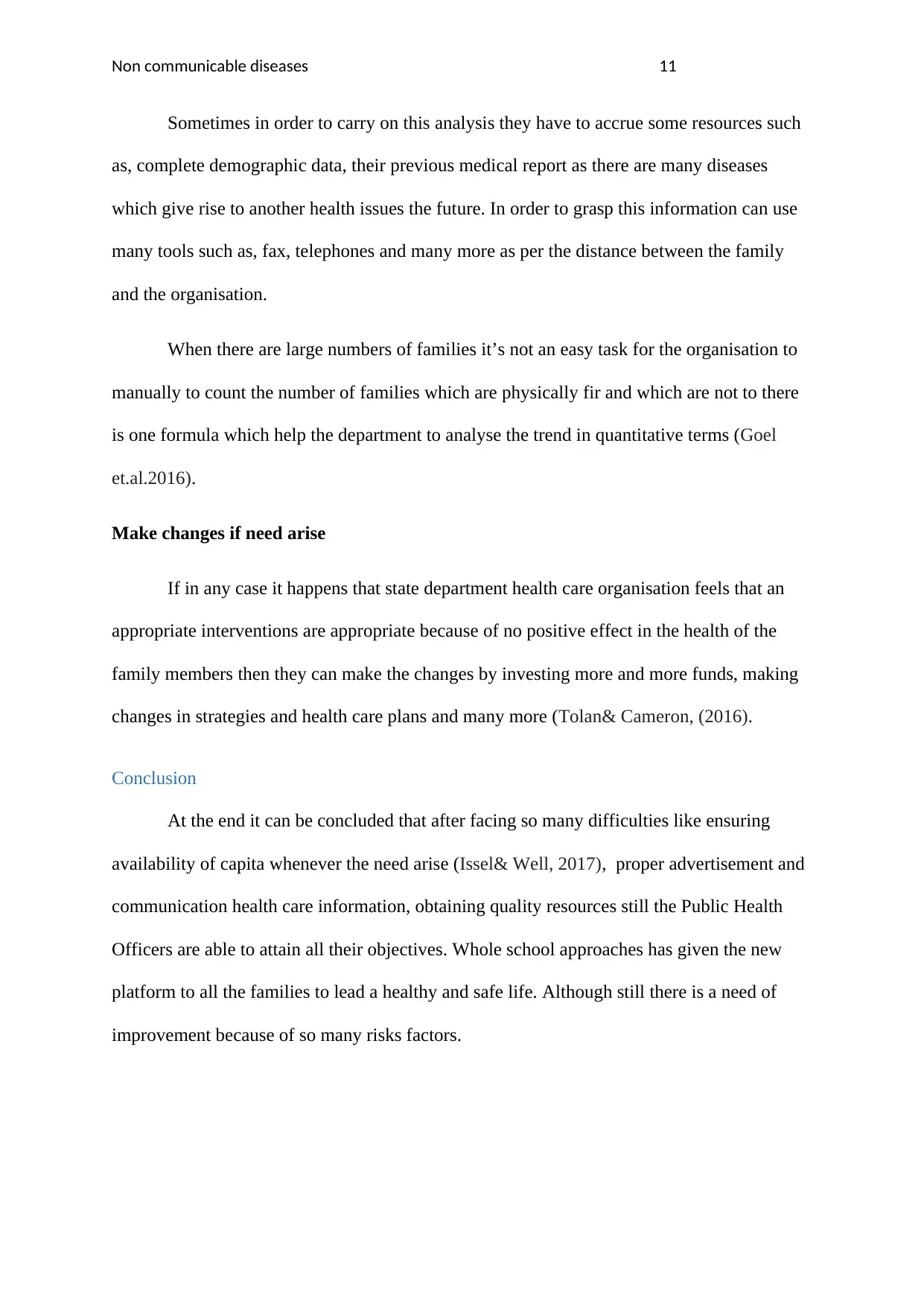
Non communicable diseases 11
Sometimes in order to carry on this analysis they have to accrue some resources such
as, complete demographic data, their previous medical report as there are many diseases
which give rise to another health issues the future. In order to grasp this information can use
many tools such as, fax, telephones and many more as per the distance between the family
and the organisation.
When there are large numbers of families it’s not an easy task for the organisation to
manually to count the number of families which are physically fir and which are not to there
is one formula which help the department to analyse the trend in quantitative terms (Goel
et.al.2016).
Make changes if need arise
If in any case it happens that state department health care organisation feels that an
appropriate interventions are appropriate because of no positive effect in the health of the
family members then they can make the changes by investing more and more funds, making
changes in strategies and health care plans and many more (Tolan& Cameron, (2016).
Conclusion
At the end it can be concluded that after facing so many difficulties like ensuring
availability of capita whenever the need arise (Issel& Well, 2017), proper advertisement and
communication health care information, obtaining quality resources still the Public Health
Officers are able to attain all their objectives. Whole school approaches has given the new
platform to all the families to lead a healthy and safe life. Although still there is a need of
improvement because of so many risks factors.
Sometimes in order to carry on this analysis they have to accrue some resources such
as, complete demographic data, their previous medical report as there are many diseases
which give rise to another health issues the future. In order to grasp this information can use
many tools such as, fax, telephones and many more as per the distance between the family
and the organisation.
When there are large numbers of families it’s not an easy task for the organisation to
manually to count the number of families which are physically fir and which are not to there
is one formula which help the department to analyse the trend in quantitative terms (Goel
et.al.2016).
Make changes if need arise
If in any case it happens that state department health care organisation feels that an
appropriate interventions are appropriate because of no positive effect in the health of the
family members then they can make the changes by investing more and more funds, making
changes in strategies and health care plans and many more (Tolan& Cameron, (2016).
Conclusion
At the end it can be concluded that after facing so many difficulties like ensuring
availability of capita whenever the need arise (Issel& Well, 2017), proper advertisement and
communication health care information, obtaining quality resources still the Public Health
Officers are able to attain all their objectives. Whole school approaches has given the new
platform to all the families to lead a healthy and safe life. Although still there is a need of
improvement because of so many risks factors.
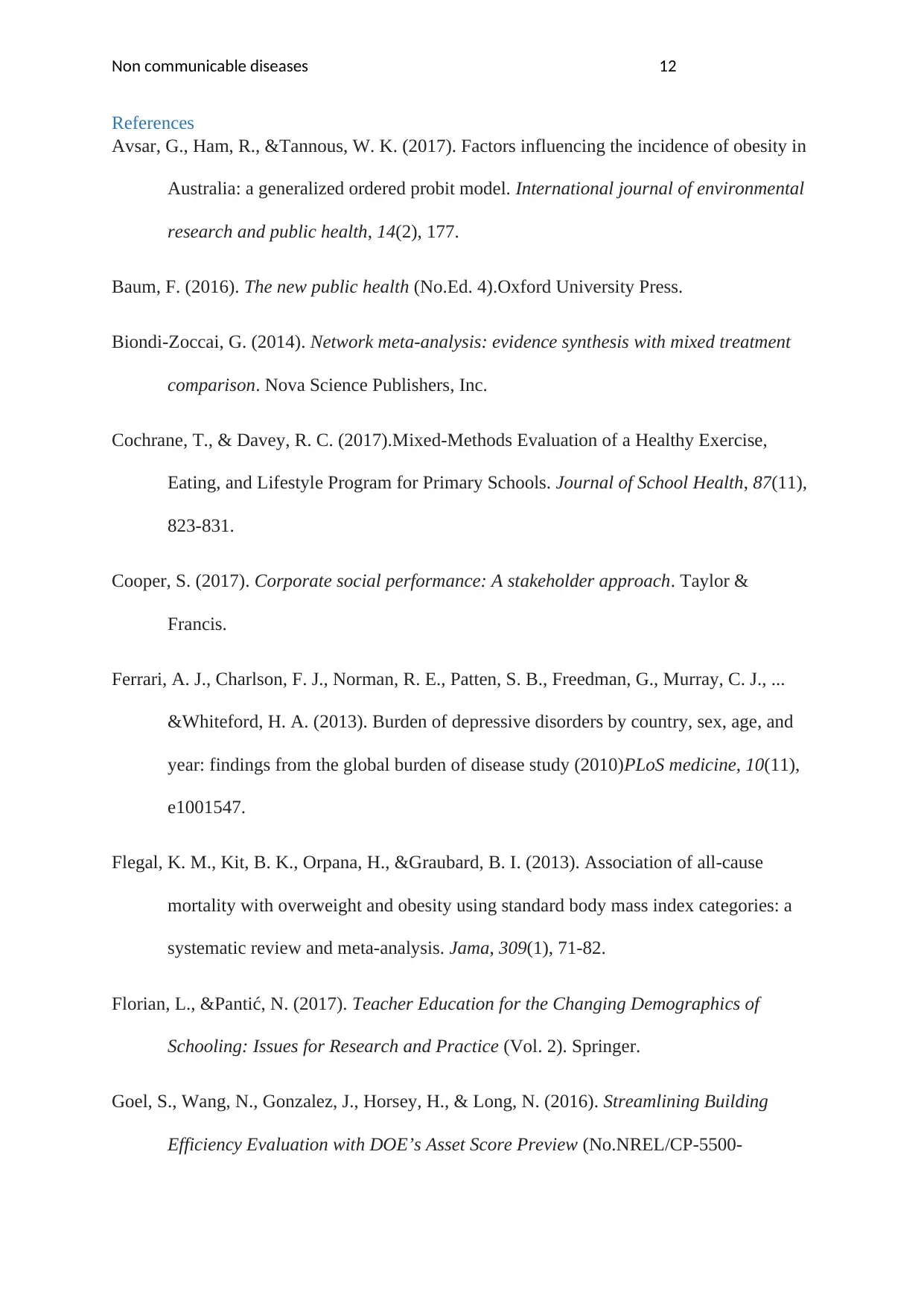
Non communicable diseases 12
References
Avsar, G., Ham, R., &Tannous, W. K. (2017). Factors influencing the incidence of obesity in
Australia: a generalized ordered probit model. International journal of environmental
research and public health, 14(2), 177.
Baum, F. (2016). The new public health (No.Ed. 4).Oxford University Press.
Biondi-Zoccai, G. (2014). Network meta-analysis: evidence synthesis with mixed treatment
comparison. Nova Science Publishers, Inc.
Cochrane, T., & Davey, R. C. (2017).Mixed‐Methods Evaluation of a Healthy Exercise,
Eating, and Lifestyle Program for Primary Schools. Journal of School Health, 87(11),
823-831.
Cooper, S. (2017). Corporate social performance: A stakeholder approach. Taylor &
Francis.
Ferrari, A. J., Charlson, F. J., Norman, R. E., Patten, S. B., Freedman, G., Murray, C. J., ...
&Whiteford, H. A. (2013). Burden of depressive disorders by country, sex, age, and
year: findings from the global burden of disease study (2010)PLoS medicine, 10(11),
e1001547.
Flegal, K. M., Kit, B. K., Orpana, H., &Graubard, B. I. (2013). Association of all-cause
mortality with overweight and obesity using standard body mass index categories: a
systematic review and meta-analysis. Jama, 309(1), 71-82.
Florian, L., &Pantić, N. (2017). Teacher Education for the Changing Demographics of
Schooling: Issues for Research and Practice (Vol. 2). Springer.
Goel, S., Wang, N., Gonzalez, J., Horsey, H., & Long, N. (2016). Streamlining Building
Efficiency Evaluation with DOE’s Asset Score Preview (No.NREL/CP-5500-
References
Avsar, G., Ham, R., &Tannous, W. K. (2017). Factors influencing the incidence of obesity in
Australia: a generalized ordered probit model. International journal of environmental
research and public health, 14(2), 177.
Baum, F. (2016). The new public health (No.Ed. 4).Oxford University Press.
Biondi-Zoccai, G. (2014). Network meta-analysis: evidence synthesis with mixed treatment
comparison. Nova Science Publishers, Inc.
Cochrane, T., & Davey, R. C. (2017).Mixed‐Methods Evaluation of a Healthy Exercise,
Eating, and Lifestyle Program for Primary Schools. Journal of School Health, 87(11),
823-831.
Cooper, S. (2017). Corporate social performance: A stakeholder approach. Taylor &
Francis.
Ferrari, A. J., Charlson, F. J., Norman, R. E., Patten, S. B., Freedman, G., Murray, C. J., ...
&Whiteford, H. A. (2013). Burden of depressive disorders by country, sex, age, and
year: findings from the global burden of disease study (2010)PLoS medicine, 10(11),
e1001547.
Flegal, K. M., Kit, B. K., Orpana, H., &Graubard, B. I. (2013). Association of all-cause
mortality with overweight and obesity using standard body mass index categories: a
systematic review and meta-analysis. Jama, 309(1), 71-82.
Florian, L., &Pantić, N. (2017). Teacher Education for the Changing Demographics of
Schooling: Issues for Research and Practice (Vol. 2). Springer.
Goel, S., Wang, N., Gonzalez, J., Horsey, H., & Long, N. (2016). Streamlining Building
Efficiency Evaluation with DOE’s Asset Score Preview (No.NREL/CP-5500-
Paraphrase This Document
Need a fresh take? Get an instant paraphrase of this document with our AI Paraphraser
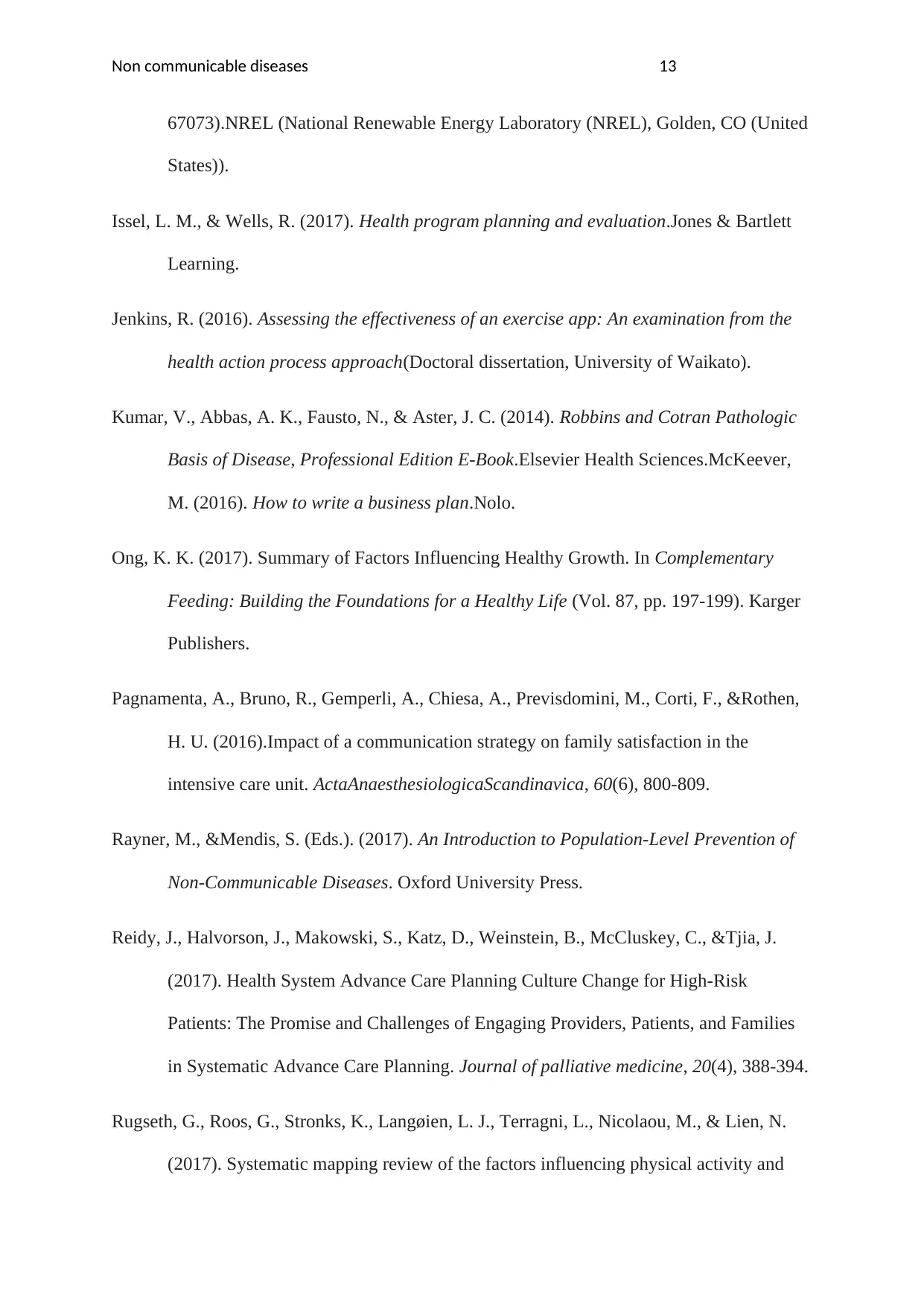
Non communicable diseases 13
67073).NREL (National Renewable Energy Laboratory (NREL), Golden, CO (United
States)).
Issel, L. M., & Wells, R. (2017). Health program planning and evaluation.Jones & Bartlett
Learning.
Jenkins, R. (2016). Assessing the effectiveness of an exercise app: An examination from the
health action process approach(Doctoral dissertation, University of Waikato).
Kumar, V., Abbas, A. K., Fausto, N., & Aster, J. C. (2014). Robbins and Cotran Pathologic
Basis of Disease, Professional Edition E-Book.Elsevier Health Sciences.McKeever,
M. (2016). How to write a business plan.Nolo.
Ong, K. K. (2017). Summary of Factors Influencing Healthy Growth. In Complementary
Feeding: Building the Foundations for a Healthy Life (Vol. 87, pp. 197-199). Karger
Publishers.
Pagnamenta, A., Bruno, R., Gemperli, A., Chiesa, A., Previsdomini, M., Corti, F., &Rothen,
H. U. (2016).Impact of a communication strategy on family satisfaction in the
intensive care unit. ActaAnaesthesiologicaScandinavica, 60(6), 800-809.
Rayner, M., &Mendis, S. (Eds.). (2017). An Introduction to Population-Level Prevention of
Non-Communicable Diseases. Oxford University Press.
Reidy, J., Halvorson, J., Makowski, S., Katz, D., Weinstein, B., McCluskey, C., &Tjia, J.
(2017). Health System Advance Care Planning Culture Change for High-Risk
Patients: The Promise and Challenges of Engaging Providers, Patients, and Families
in Systematic Advance Care Planning. Journal of palliative medicine, 20(4), 388-394.
Rugseth, G., Roos, G., Stronks, K., Langøien, L. J., Terragni, L., Nicolaou, M., & Lien, N.
(2017). Systematic mapping review of the factors influencing physical activity and
67073).NREL (National Renewable Energy Laboratory (NREL), Golden, CO (United
States)).
Issel, L. M., & Wells, R. (2017). Health program planning and evaluation.Jones & Bartlett
Learning.
Jenkins, R. (2016). Assessing the effectiveness of an exercise app: An examination from the
health action process approach(Doctoral dissertation, University of Waikato).
Kumar, V., Abbas, A. K., Fausto, N., & Aster, J. C. (2014). Robbins and Cotran Pathologic
Basis of Disease, Professional Edition E-Book.Elsevier Health Sciences.McKeever,
M. (2016). How to write a business plan.Nolo.
Ong, K. K. (2017). Summary of Factors Influencing Healthy Growth. In Complementary
Feeding: Building the Foundations for a Healthy Life (Vol. 87, pp. 197-199). Karger
Publishers.
Pagnamenta, A., Bruno, R., Gemperli, A., Chiesa, A., Previsdomini, M., Corti, F., &Rothen,
H. U. (2016).Impact of a communication strategy on family satisfaction in the
intensive care unit. ActaAnaesthesiologicaScandinavica, 60(6), 800-809.
Rayner, M., &Mendis, S. (Eds.). (2017). An Introduction to Population-Level Prevention of
Non-Communicable Diseases. Oxford University Press.
Reidy, J., Halvorson, J., Makowski, S., Katz, D., Weinstein, B., McCluskey, C., &Tjia, J.
(2017). Health System Advance Care Planning Culture Change for High-Risk
Patients: The Promise and Challenges of Engaging Providers, Patients, and Families
in Systematic Advance Care Planning. Journal of palliative medicine, 20(4), 388-394.
Rugseth, G., Roos, G., Stronks, K., Langøien, L. J., Terragni, L., Nicolaou, M., & Lien, N.
(2017). Systematic mapping review of the factors influencing physical activity and
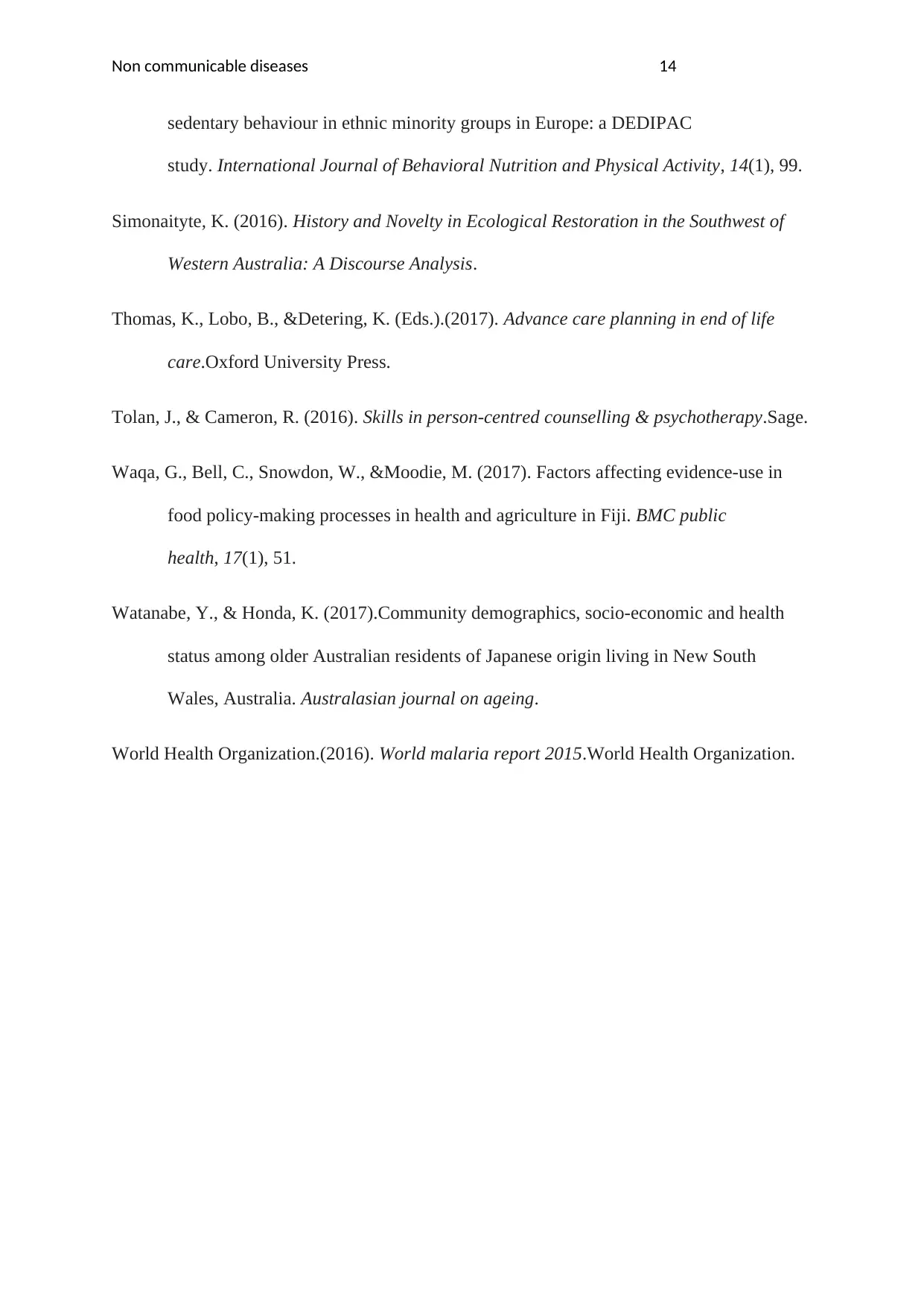
Non communicable diseases 14
sedentary behaviour in ethnic minority groups in Europe: a DEDIPAC
study. International Journal of Behavioral Nutrition and Physical Activity, 14(1), 99.
Simonaityte, K. (2016). History and Novelty in Ecological Restoration in the Southwest of
Western Australia: A Discourse Analysis.
Thomas, K., Lobo, B., &Detering, K. (Eds.).(2017). Advance care planning in end of life
care.Oxford University Press.
Tolan, J., & Cameron, R. (2016). Skills in person-centred counselling & psychotherapy.Sage.
Waqa, G., Bell, C., Snowdon, W., &Moodie, M. (2017). Factors affecting evidence-use in
food policy-making processes in health and agriculture in Fiji. BMC public
health, 17(1), 51.
Watanabe, Y., & Honda, K. (2017).Community demographics, socio‐economic and health
status among older Australian residents of Japanese origin living in New South
Wales, Australia. Australasian journal on ageing.
World Health Organization.(2016). World malaria report 2015.World Health Organization.
sedentary behaviour in ethnic minority groups in Europe: a DEDIPAC
study. International Journal of Behavioral Nutrition and Physical Activity, 14(1), 99.
Simonaityte, K. (2016). History and Novelty in Ecological Restoration in the Southwest of
Western Australia: A Discourse Analysis.
Thomas, K., Lobo, B., &Detering, K. (Eds.).(2017). Advance care planning in end of life
care.Oxford University Press.
Tolan, J., & Cameron, R. (2016). Skills in person-centred counselling & psychotherapy.Sage.
Waqa, G., Bell, C., Snowdon, W., &Moodie, M. (2017). Factors affecting evidence-use in
food policy-making processes in health and agriculture in Fiji. BMC public
health, 17(1), 51.
Watanabe, Y., & Honda, K. (2017).Community demographics, socio‐economic and health
status among older Australian residents of Japanese origin living in New South
Wales, Australia. Australasian journal on ageing.
World Health Organization.(2016). World malaria report 2015.World Health Organization.
1 out of 15
Related Documents
Your All-in-One AI-Powered Toolkit for Academic Success.
+13062052269
info@desklib.com
Available 24*7 on WhatsApp / Email
![[object Object]](/_next/static/media/star-bottom.7253800d.svg)
Unlock your academic potential
© 2024 | Zucol Services PVT LTD | All rights reserved.




